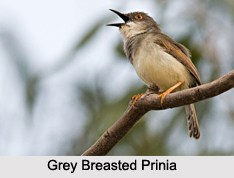 Grey-Breasted Prinia or Franklin`s Prinia is an Indian Bird that bears a scientific name "Prinia hodgsonii" and it is the resident breeder in Indian states and Asian sub continent.
Grey-Breasted Prinia or Franklin`s Prinia is an Indian Bird that bears a scientific name "Prinia hodgsonii" and it is the resident breeder in Indian states and Asian sub continent.
Category of Grey-Breasted Prinia
Grey-Breasted Prinia is a wren-warbler belonging to the family of small passerine birds found mainly in warmer southern regions of the Old World.
Breeding of Grey-Breasted Prinia
Grey-Breasted Prinia is a resident breeder in the Indian subcontinent, Sri Lanka and Southeast Asia.
Structure of Grey-Breasted Prinia
Grey-Breasted Prinia often holds the tail upright but it is easily told by a smoky grey band across the breast which contrasts with a white throat. The beak is all black while the legs are pink. The tail is graduated as in other Prinias and the grey feathers are tipped in white. In the breeding plumage the upperparts are grey while non-breeding birds are pale above with rufous wings and a weak supercilium.
Habitat of Grey-Breasted Prinia
Grey-Breasted Prinia is found in scrub, forest clearings and other open but well vegetated habitats. It can be confused with the Rufescent Prinia.
Description of Grey-Breasted Prinia
Grey-Breasted Prinia was named by James Franklin as Prinia gracilis in 1831 based on a specimen that he obtained on the Ganga River between Kolkata and Varanasi, Uttar Pradesh. It was renamed as Prinia hodgsonii by Edward Blyth in 1844 since the name Sylvia Gracilis had been in use for the graceful prinia (described earlier in 1823 by Martin Lichtenstein) clashed when treated in the same genus Prinia. It was also described as Prinia adamsi by Jerdon and as Prinia humilis by Hume. This was placed in a separate genus Franklinia by Blyth and this treatment was followed by Jerdon and by others including Hugh Whistler who separated this species from the genus Prinia and placed it in the genus Franklinia which he considered distinct on the basis of having twelve tail feathers rather than ten and in having distinct breeding and non-breeding plumages. The merging of Prinia and Franklinia was supported by H. G. Deignan.
Structure of Grey-Breasted Prinia
Grey-Breasted Prinia is about 11-to-13-centimetre in size. It is long warblers having a long grey tail with graduated feathers that are tipped in white. They have strong pinkish legs and a short black bill. The eye ring is orange.
Sexes of Grey-Breasted Prinia
The sexes of Grey-Breasted Prinia look alike in most populations except in P. H. Pectoralis of Sri Lanka where the female can be identified by the incomplete breast band. The under parts are buff white and the grey breast band contrasts with the white throat in the breeding season. They have a rufous wing panel and the upperparts are smoky grey during the breeding season and olive brown in the non-breeding period. Non-Breeding birds have a short indistinct white supercilium and often lack the breast band. Young birds are like non-breeding adults but more rufous above. The distinctive greyer endemic race in Sri Lanka, P. H. Pectoralis, retains the summer-type plumage all year round. Young birds have a pale lower mandible. The tail feathers are shorter in summer than in the non-breeding winter plumage.
Concentration of Grey-Breasted Prinia
Grey-Breasted Prinia is a common resident of the Indian peninsula. It migrates slightly south during winter. The distribution extends from Himalayan Mountain Range to Southern India and to eastern Indian states Arunachal Pradesh, Nagaland, Manipur, Meghalaya and Assam. The species distribution extends to Pakistan, Burma, Vietnam, Sri Lanka and Yunnan province in southern China. Its altitude ranges from plains and goes up to 1000 meters (3280 ft) P. H. Hodgsonii and up to 1800 meters (5900 ft) P. H. Rufula in Meghalaya.
Feeding of Grey-Breasted Prinia
Grey-Breasted Prinia feeds mainly on insects like ants, small beetles, caterpillars which are found among twigs and foliage of small trees. They also feeds on nectar from blossoms of trees like Erythrina and Bombax and during summer their forehead is sometimes sprinkled with pollen giving them an orange or yellowish head that can lead to mistaken identification.
Breeding of Grey-Breastzed Prinia
The breeding season of Grey-Breasted Prinia begins with the rains. The male sings from a high perch and also performs aerobatic manoeuvers with rising and falling before diving with song notes.











